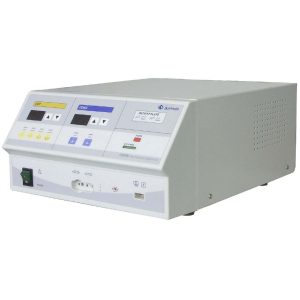The cutting procedure can be performed with the monopolar technique. In this case, a small working tip is used as an active electrode, while the neutral electrode is applied to the body in a large area away from the surgical field. As a result, virtually no energy is released into the neutral electrode when current flows, because “current leakage” is distributed over a large area.
In the active electrode, the “current input” is now concentrated in a small inlet area, simply by the choice of its geometric shape (needle, sphere, surface shape) and can thus be controlled manually. In addition, modulated currents can be used differently to achieve different effects:
- Pure cut: sharp cut with minimal lateral coagulation.
- Coagulation: strong lateral coagulation of tissue, also in depth.
- Cutting plus clotting: Combination for lateral hemostasis during cutting.
- Fulguration: Strong surface tissue coagulation and vaporization.
A typical form of application is the needle-shaped monopolar cut electrode or loop electrode for wart and polyp resection and gingivectomy. Fulguration is deliberate superficial destruction of tissue by inducing a spark, for example, to remove eosinophilic plaques or hypertrophy of superficial tissue.
How does cutting the tissues with the electroscalpel happen?
Tissue separation occurs as a result of the application of electrical sparks. These sparks produce intense heat where they are applied in rather short periods of time. The production of a maximum concentration of current ends up vaporizing the tissue. This process, which occurs in stages, ends with the destruction of cells.
Simply put, what happens during the sudden rise in tissue temperature very quickly causes the water inside the cells to boil and water vapor to form, causing the cell to burst and disintegrate, destroying the tissue. In surgical cutting, it is usually recommended to use contact electrodes as sharp and thin as possible.
In these conditions, where a sudden increase in temperature occurs and superheated water vapor is generated, it is ensured that a sterilization of the cut occurs. Within this effect, a high-frequency sine wave should be generated, with sufficient amplitude to provide the required energy. This kind of wave is totally filtered.
The importance of safety in the use of an electroscalpel
Typical cuts that can be made with an electroscalpel, such as pure cutting and combined cutting (cutting plus clotting), differ in that the first cuts only the tissues apart during the incision, whereas the second cuts only the blood to be clotted, thus preventing blood loss. However, if all these processes are not controlled, they can be highly harmful to the body.
Complications due to electrosurgery are caused mainly by stationary currents, which cause energy to be transferred in an uncontrolled way. It must be taken into account for this reason that the patient must be completely isolated from any conductive elements, to prevent the occurrence of an electrical shock. Therefore, the importance of working in safe conditions can be summarized in two points:
- The goal is controlled vaporization of tissue at the incision site in addition to heat coagulation adapted for hemostasis of smaller vessels without tissue destruction.
- Charring due to excess energy (charring) should be avoided because it leads to necrotic wound edges and poor wound healing, and the cutting electrode becomes clogged.
Why choose a Kalstein electrosurgical generator?
As discussed in this article, it is very important to make the cuts guaranteeing a strict control of the electric current, to cauterize the small vessels and avoid the carbonization of the tissue. Therefore, we must use reliable generators, such as those offered by the manufacturer Kalstein and which can be reviewed at the following link HERE

